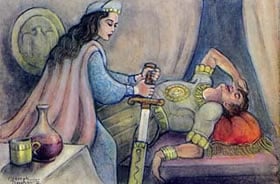Damien F. Mackey
“There is no notice of
Holofernes except in the Book of Judith. The termination of the word would seem
to indicate a Persian origin for the name. The Holofernes of Shakespeare and
Rabelais is in no way connected with the deeds of the Holofernes of the
Apocrypha”.
J. Hutchison
A Persian origin for the name “Holofernes” appears
to be the general view.
It is also supported by, for instance, John L.
Mackenzie, The Dictionary Of The Bible, according to whom: “The names Holofernes … and Bagoas … are not
Babylonian but Persian” (article, “Judith”, p. 469).
The only example that I have been able to find
in supposedly ‘historical’ text books of the combination (as found in the Book
of Judith) of officers named “Holofernes” and “Bagoas” is at the time of the
Persian king, Artaxerxes III. See my:
Artaxerxes III and Judith
and:
Medo-Persian
History Archaeologically Light. Part Three: Artaxerxes III ‘Ochus’
Although there is supposed to have been a C4th
BC general called “Orophernes”, which name would appear to be compatible with “Holofernes”,
his coinciding with the dubiously historical Persian king, Artaxerxes III (see
above), would make his historicity most uncertain indeed.
We read about this “Orophernes” in a series, A Pious Seductress: Studies in the Book of
Judith (ed. G. G Xeravits):
Fourth-century orophernes (ca. 350 BCE): The
invasion led by Holofernes seems loosely modeled on the military campaign of a fourth-century Cappadocian general named Orophernes, known
from the first-century BCE historian Diodorus Siculus (31.19.3). …. This Orophernes was the brother of the Cappadocian king Ariarathes I (13.19.2),
and he assisted
the Persian king Artaxerxes III (358-338 BCE) during his
campaign against Egypt around 350 BCE. During this military campaign Artaxerxes III also
had a trusted advisor named Bagoas (16.47.3; 17.5.3), just
as Holofernes had a
servant named Bagoas (Jdt 12:11). However, the illusion is ironic. Whereas this Orophernes aided Artaxerxes III in his ultimately successful conquest of Egypt,
Holofernes fails to capture Bethulia. ....
For a start, the Great King in the Book of Judith was not a
Persian, but an Assyrian.
So, better to say, I would suggest, that the fictitious
Orophernes and his supposed contemporary, Bagoas, but also Artaxerxes III, were
the ones who were ‘modelled on’, rather than the characters in the Book of Judith
being modelled on Orphernes, etc.
That this Orophernes was also supposedly “Cappadocian” does
nothing further to inspire confidence, given that the Hellenistic king
Antiochus IV ‘Epiphanes’ had a doppelganger:
Antiochus IV 'Epiphanes' Doubled
from that approximate region.
My conclusion would be that there never was an
Assyrian (or Babylonian, or Persian) commander-in-chief named “Holofernes” and
that this was one of several name confusions that have subsequently found their
way into the Book of Judith.
See next.
“When Josephus named
Nebuchadnezzar as builder of the [hanging] garden, both he and his readers
would have been confused between Nineveh and Babylon, and between Sennacherib
and Nebuchadnezzar, because at the time they were reading his account, the Book
of Judith was already in circulation”.
What a
terrific book! I read it in one go.
I am
referring to Stephanie Dalley’s The Mystery of the
Hanging Garden of Babylon: An Elusive World Wonder Traced (OUP, 2013).
Apart from her unscrambling of the Classical texts on the subject of the Seven
Wonders of the World, and being able to conclude that it was not Nebuchednezzar
II the Chaldean, but rather the Assyrian king Sennacherib, who created the
‘hanging’ gardens that became so famed in antiquity, Dalley provides an
abundance of important information on Assyro-Babylonian technology, art and
architecture.
Despite
the necessary technicalities, this book, written by a most disciplined
researcher - “a world expert on ancient Babylonian language” - is easy to read
and enjoyable.
In
Chapter 6, “Confusion of Names”, Dalley makes this important point (p. 107):
Several confusions have been
identified. It would be satisfactory if we could account for them, to
strengthen yet further the argument that the Hanging Garden was built by
Sennacherib in Nineveh rather than by Nebuchadnezzar or Semiramis in Babylon.
Four distinct pairs of names are relevant for tracing the story of the
legendary garden: ‘Nebuchadnezzar’ named for Sennacherib, the city name
‘Babylon’ used for Nineveh, the river ‘Euphrates’ named instead of the Tigris,
and ‘Semiramis’ confused with other queens and with ‘Nitocris”. For each of
them an explanation can be given.
When
reading Dalley’s account here of name confusion, I was immediately reminded of
the situation right at the beginning of the Book of Judith, about which I have
written much. And, indeed, the point has not been missed on Dalley either. For
she writes on the next page (p. 108), referring to Judith as a “late” text (but
I would prefer to say a late copy of the original):
Sennacherib was evidently
confused with Nebuchadnezzar in several late texts. In the opening words of the
Book of Judith the two kings are confused: ‘It was the twelfth year of
Nebuchadnezzar who reigned over the Assyrians in the great city of Nineveh’.
When Josephus named Nebuchadnezzar as builder of the garden, both he and his
readers would have been confused between Nineveh and Babylon, and between
Sennacherib and Nebuchadnezzar, because at the time they were reading his
account, the Book of Judith was already in circulation.
For my
own reconstruction of the Book of Judith’s magnificent drama as belonging
entirely to the C8th BC time of Sennacherib of Nineveh, and not to the C6th BC
Nebuchednezzar II of Babylon, see e.g. my articles:
Book of Judith Suggests Sargon as
Sennacherib
and
"Nadin" (Nadab) of Tobit is the "Holofernes" of Judith

No comments:
Post a Comment